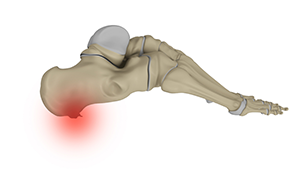HAGLUND'S Syndrome/ HEEL SPUR AKA BAUERS BUMP OR PUMP BUMP

What are Heel Spurs?
The heel is made up of the calcaneus bone and supported by a network of muscles, tendons, ligaments and soft tissues, which together support the weight of the body and stress during movement. A heel spur is a bony protrusion on the underside of the heel bone, which may not be visible to the naked eye. This condition occurs when there is a bony prominence at the back of the heel that causes inflammation of the Achilles tendon and surrounding soft tissue.
Causes of Heel Spurs
Heel spurs occur when calcium deposits build up on the underside of the heel bone, a condition that develops over time. Risk factors for heel spurs include:
- Running, especially on hard surfaces
- Hockey Players
Symptoms of Heel Spurs
Intermittent or chronic pain may be felt when walking or running, especially on hard surfaces. The cause of pain is not due to the heel spur itself, but by soft tissue injury and inflammation.
Treatment Options for Heel Spurs
Calcaneoendoplasty (Heel Spur resection with Achilles Arthroscopy):
A haglunds resection can be performed with an open procedure or more recently, with an arthroscopic approach. The approach taken in my office is minimally invasive and done arthroscopically. During a calcaneoendoplasty, the heel spur will be removed and a scope/debridement of the Achilles tendon will be done. The arthroscopy done, in conjunction to the spur removal, will decrease inflammation of the irritated tendon. To complete the procedure, stem cells drawn from the patient’s hip will be injected into the site to promote healing.
Dr. Kennedy’s Articles
Physician and patient based outcomes following surgical resection of Haglund's deformity
AANA chapter on Haglund’s Deformity
Kennedy, J., 2016. Halgund’s Deformity: Endoscopic Calcaneoplasty. In: Y. Yasui, E. Fraser and J. Kennedy, ed., The Foot and Ankle: AANA Advanced Arthroscopic Surgical Techniques
















